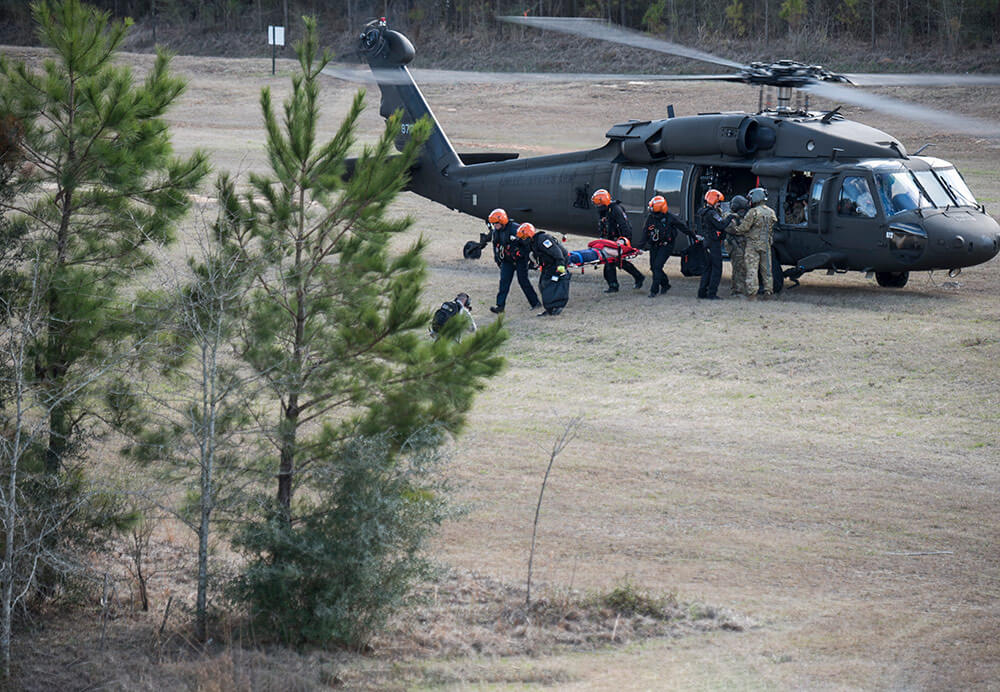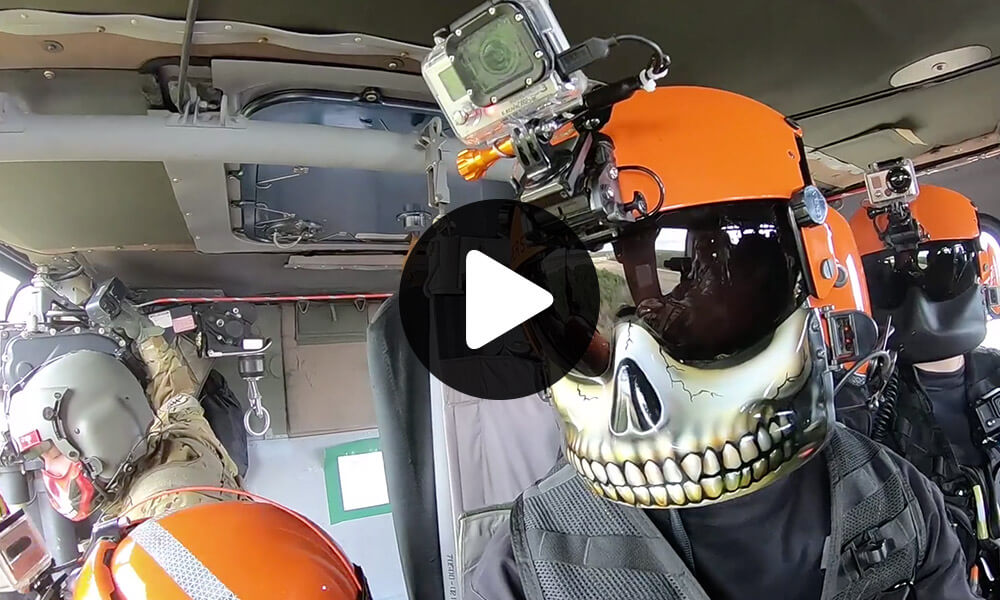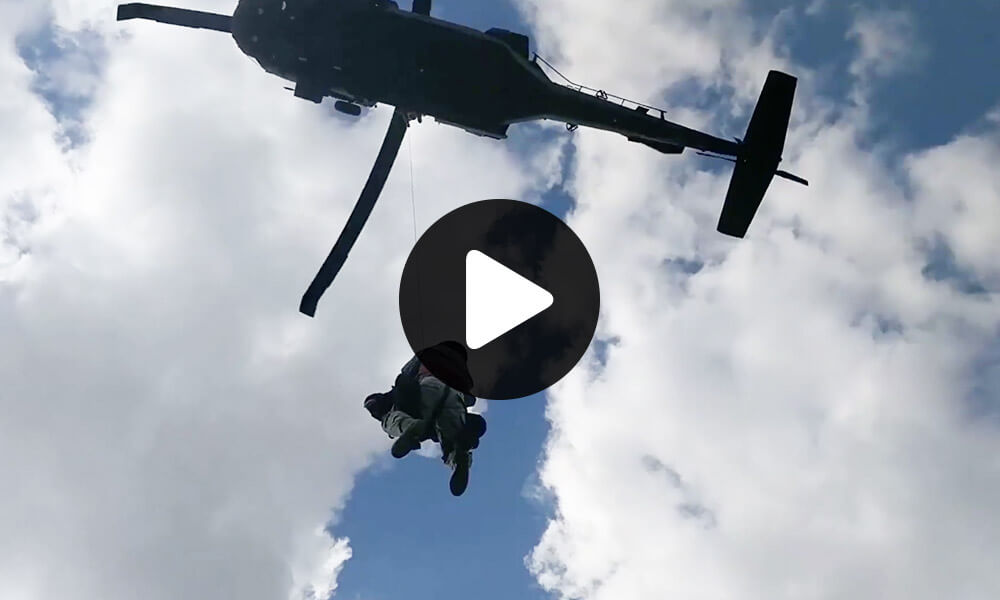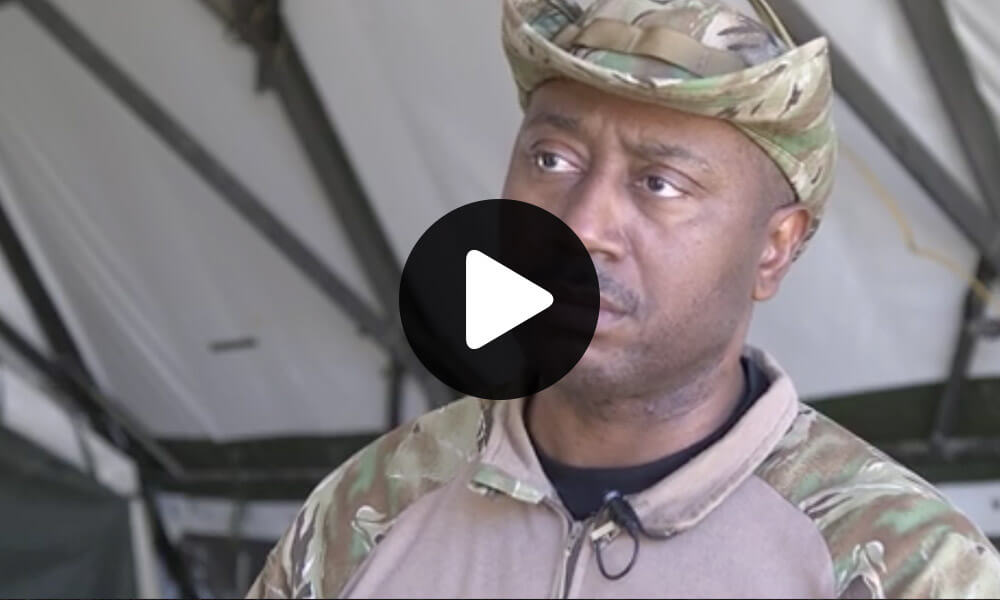2018 Patriot Exercises Epitomize National Guard Mission
The National Guard has experienced a historic year of responding to weather and natural disasters. With catastrophic hurricanes, raging wildfires and volcano eruptions, Guard Soldiers have epitomized the “Always Ready, Always There” motto more than ever.

Nevertheless, in an unpredictable world, there will always be new threats to defend against. To prepare for the natural disasters and emergencies that have yet to come, members from the Army and Air National Guard participated in Patriot South 2018, an emergency response training exercise with the goal of increasing the ability of federal, State and local agencies to respond in unison to a natural or man-made emergency.
Patriot South is one leg of what is a two-part series of exercises – Patriot North, held in the northern regions of the United States and Patriot South, which is held in the southern regions.
With participation from 1,900 military and civilian personnel, the Patriot exercises garnered National Guard representation from 46 States and 86 units and wings.
“This exercise is really the only exercise where our National Guard units are able to hit the three tiers [of the National Guard mission],” explained Capt Michelle Clark, of the 130th Air Wing, West Virginia Air National Guard and Patriot South project manager. “The first thing is our homeland response, so we are validating State’s all-hazards plan. We are also building partnerships. Not only our partnership between the Air Guard and the Army Guard, but our partnerships with our civilian communities. And at the same time, we are still getting our wartime training needs met. [Guard members] are doing the same job responding to a hurricane and evacuating patients as they do when they are downrange.”

Sponsored by the National Guard Bureau and accredited by the Joint National Training Capability (JNTC) program, this year’s Patriot South exercise was held at the Combined Arms Combat Training Facility (CACTF) at Camp Shelby, Mississippi, from Feb. 12–15.
The exercise provided Guard members with critical training in domestic operations while coordinating with civilian partners. There was participation from numerous civilian entities, including Mississippi Emergency Management and the Mississippi Office of Homeland Security.
“It’s a training venue where, just like in a real-world event, you are able to bring the military side of it and work together with the civilian partners,” explained LTC Douglas Leslie, battalion commander for South Carolina Army National Guard’s 2-151 Security and Support Aviation Battalion. “You have multiple agencies coming together and learning how to work with each other and how best to respond to events, whether it’s a hurricane, earthquake or wildfire. It allows multiple agencies from across the country to come together and collectively try to better respond and give support that the citizens will need.”
Patriot simulated an earthquake in Mississippi, a realistic simulation given the State’s proximity to the New Madrid Seismic Zone – a prolific source of earthquakes. Organizers set up venues at Camp Shelby to simulate collapsed structures with victims inside.
The exercise offered a realistic environment, mimicking how units would need to respond if they were called upon during a real disaster.

“The exercise was fantastic as far as the layout and what it gave us,” said SSG Steven Hughes, crew chief, Alpha Company, 1-111th Aviation Regiment, South Carolina Army National Guard. “We didn’t have any part in the planning. We just knew that we were going down to an earthquake in Mississippi and that was pretty much all we knew. It played out real life. You get a call, you get down there and you have to assess and see what’s going on.”
While communication and teamwork are key elements in the success of any exercise, the number of organizations partnering in Patriot South made it crucial for team members to remember that good communication is not just about sending information, but also about ensuring that information is understood.
“We are working with our civilian partners, like the emergency operations centers, firefighters, police officers and search and rescue, so initially it’s a challenge because we speak different ‘languages,’” Capt Clark said. “It’s initially challenging, but it works itself out during the planning process and the execution.”
As with a real disaster, the exercise saw its share of challenges. A government shutdown and less than ideal weather in southern Mississippi caused delays during the exercise.

“The weather hampered us a couple of days, and we were late deploying to the exercise due to the budget not being resolved,” said LTC Leslie. “All of these real-world issues that were injected into the training were like when we have a mission and are called up to support. It helped Soldiers, staff and officers develop a better understanding of what they will face when the [real] time comes and how to work around problems to develop a good solution.”
LTC Leslie said he was impressed by how his battalion performed, despite the delays.
“We were able to deploy the battalion from South Carolina to Mississippi [and back], both in multiple flights of aircraft,” LTC Leslie said. “For the convoys there and back, we put in just around 38,000 vehicle miles with no issues or accidents. It’s a proud moment knowing that they did it without a single incident.”
South Carolina Army National Guard participated in Patriot South through their Helicopter Aquatic Rescue Team (HART), a State program consisting of civilian and military assets, and provided aviation support during the exercise. The program is a joint venture that teams Guard members with civilian emergency responders who are trained in emergency rescues.
“The Guard provides the air crews and the aircraft, while civilian agencies supply us with the paramedics and firefighters,” explained SSG Hughes. “Whether it’s a flood or someone falling off of a mountain, we’ll fly up there and pick up the crew of the civilian entity. Then we use the aircraft and hoist the rescuers down, hoist them back up and fly that person to higher care.”
South Carolina HART (SC-HART) came to the Patriot South exercise with a dose of real-world missions fresh in their minds, having recently served in response to last year’s hurricanes.
“Our role [here at Patriot South], just like in any real natural disaster or anytime that we are called up to serve, was providing aviation support for the State,” LTC Leslie explained. “We deployed assets to both Houston and Puerto Rico, so we had that under our belt and were able to bring real-world experience to the training scenario.”
Patriot South provided participants the opportunity to hone the skills required for each group to properly execute their unique role in an emergency situation. Soldiers were given a venue where they could put their specific training to the test and watch it play out on a large scale.
“We were responsible for the hoist operation,” said SGT Bryon Lunsford, SC-HART crew chief for the 2-151st. “We train regularly for it and [during the exercise] had people on helicopter cables with multiple aircraft in the same vicinity, so it was a big deal. Being able to rescue people off of building tops was exciting.”
SSG Hughes noted how the experience of the exercise directly aligned with the Guard’s core mission.
“Any natural disaster, whether it’s hurricane Harvey, floods or an earthquake in Mississippi, we are going to be the ones responding,” he said. “It’s going to be the Guard doing their State mission. That’s one of the biggest reasons why it’s a great exercise. It helps us grow and learn a little bit more about what we are supposed to do in the event we have a natural disaster.”
The second leg of the exercise, Patriot North, occurred July 14–20 and was hosted by both the Wisconsin Army National Guard at Fort McCoy and the Wisconsin Air National Guard at Volk Field Combat Readiness Training Center. Like Patriot South, the exercise simulated an emergency that required a joint response from military and civilian personnel.
“The great advantage of [Patriot exercises] is the realism it provides the Guard and our partners,” said Lt Col Roger Brooks, exercise director for the Patriot exercises (both North and South) and commander of the 116th Security Forces Squadron, Georgia Air National Guard. “These exercises will help all of us prepare for any disaster.”
While exemplifying the core missions of the National Guard, the 2018 Patriot North and South exercises provided realistic and challenging training environments where Guard members could broaden their skill sets and increase their understanding of joint emergency responses.
“This is the time that we can plan for when a disaster does hit,” said SSG Hughes. “I think all of us are looking forward to next year’s exercise to really see it grow and play out.”
By STAFF WRITER Tatyana White-Jenkins







